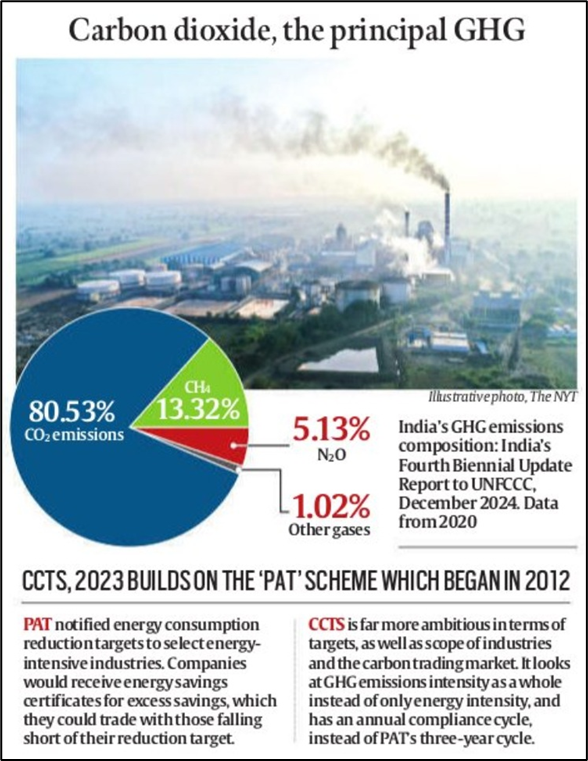Why in News?
The Ministry of Environment, Forest and Climate Change has released the Draft Greenhouse Gases Emissions Intensity (GEI) Target Rules, 2025.
These rules set emission reduction targets for "obligated entities" in energy-intensive sectors and establish a compliance mechanism under the Carbon Credit Trading Scheme (CCTS), 2023.
The CCTS aims to enable carbon credit trading to reduce emissions and support India’s climate goals under the 2015 Paris Agreement.
What’s in Today’s Article?
- Greenhouse Gases (GHGs)
- Greenhouse Gases Emissions Intensity (GEI)
- Summary of Draft GEI Target Rules
- Draft Rules Tie into India’s Carbon Credit Trading Scheme
Greenhouse Gases (GHGs)
- GHGs are gases that trap heat in the atmosphere, contributing to the "greenhouse effect" and raising Earth's surface temperature.
- The five most abundant GHGs are water vapour, carbon dioxide, methane, nitrous oxide, and ozone.
- Other GHGs include synthetic gases like chlorofluorocarbons (CFCs) and hydrochlorofluorocarbons (HCFCs).
Greenhouse Gases Emissions Intensity (GEI)
- GEI refers to the amount of GHGs emitted per unit of product output, such as emissions per tonne of cement, aluminium, or paper produced.
- Definitions under the Draft Rules
- GEI Definition: The Draft Greenhouse Gases Emissions Intensity (GEI) Target Rules, 2025, define GEI as "greenhouse gases emission intensity in tCO₂e/ equivalent output or product."
- tCO₂e Meaning: tCO₂e (tonnes of carbon dioxide equivalent) is the standard unit used to measure the warming impact of all GHGs.
Summary of Draft GEI Target Rules
- Baseline Emissions & Reduction Targets
- Establishes 2023-24 as the baseline year for emissions.
- Gradual GHG reduction targets set for 2025-26 and 2026-27.
- Part of India's Carbon Credits Trading Scheme, 2023.
- Industries & Entities Covered
- Applies to energy-intensive industries:
- Aluminium – 13 plants
- Cement – 186 plants
- Pulp & Paper – 53 plants
- Chlor-Alkali – 30 plants
- Total of 282 industrial units affected.
- Major Companies Assigned Targets
- Includes leading corporations such as:
- Vedanta, Hindalco, Bharat Aluminium, SW Cement, Ultratech, Nalco, JK Cement, Dalmia Cement, Shree Cement, Grasim Industries, and JK Paper.
- Compliance & Penalties
- Rules define compliance mechanisms for industries.
- Penalties prescribed for non-compliance with reduction targets.
Carbon Credit Trading Scheme (CCTS) 2023 and Its Importance

- Foundation: The PAT Scheme (Since 2012)
- PAT (Perform, Achieve, Trade) was launched in 2012 to enhance energy efficiency.
- It set energy consumption reduction targets for selected energy-intensive industries.
- Companies achieving more than their targets earned Energy Saving Certificates (ESCerts), which could be traded with those who underperformed.
- Evolution: Carbon Credit Trading Scheme (CCTS), 2023
- CCTS builds upon the PAT scheme, expanding the focus from energy efficiency to greenhouse gas (GHG) emissions reduction.
- It introduces GHG emissions intensity (GEI) reduction targets specific to industries.
- Why Industry-Specific Targets Matter
- Critical to achieving India’s climate goals and low-carbon growth.
- Helps industries reduce, remove, or avoid GHG emissions.
- Example: Cement plants can lower emissions by using biomass instead of coal or adopting energy-efficient kilns.
- Alignment with International Commitments
- Supports India’s Paris Agreement pledge:
- Reduce emissions intensity of GDP by 45% by 2030 (compared to 2005 levels).
- Encourages the adoption of sustainable and advanced technologies in high-emission sectors.
- Key Objective
- Drive systemic change in emission-heavy industries by integrating climate action with industrial growth.
How do these Draft Rules Tie into India’s Carbon Credit Trading Scheme?
- Framework of the Carbon Credit Trading Scheme (CCTS)
- CCTS establishes a system for generating, trading, and utilizing carbon credit certificates.
- Inspired by Article 17 of the Kyoto Protocol, which allowed trading of unused emission units among countries.
- Role of GEI Targets in Carbon Credit Generation
- GHG Emission Intensity (GEI) targets clearly define goals for industries.
- Industries must prepare action plans to achieve these targets.
- Carbon credits are awarded to industries that reduce their emissions intensity.
- Trading and Compliance Mechanism
- The trade mainly revolves around carbon dioxide, the principal GHG.
- Carbon credits are traded on the Indian Carbon Market platform.
- Oversight by: Bureau of Energy Efficiency (BEE), Union Ministry of Power.
- Industries falling short must either:
- Buy credits to cover the gap, or
- Face penalties imposed by the Central Pollution Control Board (CPCB).
- Incentives for Industries
- Availability of carbon credits motivates industries to decarbonize.
- Resource-rich industries can adopt clean technologies and profit from surplus credits.
- Resource-constrained industries can transition gradually by purchasing credits.
- Global Context
- Similar carbon credit markets have been operational: Europe since 2005; China since 2021.









